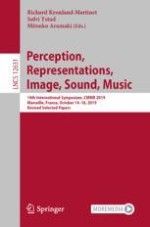2021 | OriginalPaper | Chapter
Tapping Along to the Difficult Ones: Leveraging User-Input for Beat Tracking in Highly Expressive Musical Content
Authors : António Sá Pinto, Matthew E. P. Davies
Published in: Perception, Representations, Image, Sound, Music
Publisher: Springer International Publishing
Activate our intelligent search to find suitable subject content or patents.
Select sections of text to find matching patents with Artificial Intelligence. powered by
Select sections of text to find additional relevant content using AI-assisted search. powered by
